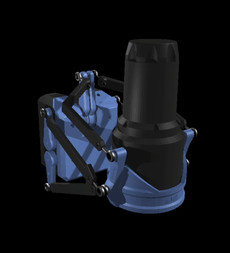Overview
What is the SR6?
The SR6 is a Multi-Axis Stroker Robot (MAxSR) designed to hold and move a standard fleshlight, or similar toy, with six degrees of freedom (adapters are available for soft, sleeveless toys like onaholes).
It is constructed from a combination of 3D printed plastic and commercial off-the-shelf components. It is designed to be home built, modifiable, and user-repairable.
The design is based around a modified Stewart platform with six servos driving six arms, which connect to the receiver via six linkages. The arrangement gives a theoretical total movement range of 120mm in the up-down direction and 60mm in the left-right and forward-backward directions. The receiver can simultaneously also rotate in roll and pitch by approximately ±30 degrees, and twist for up to ±135°.
Control is achieved via a generic open source USB serial protocol called T-Code. The SR6 uses an ESP32 microcontroller to receive these simple commands and calculate the appropriate control angles for each of the servos, to achieve the desired position for the receiver.
Like OSR2, the SR6 is a hands-free machine that mounts to a standard VESA 100mm hole pattern, using 4x M4 bolts. This means that an enormous range of mounting options, mostly in the form of display and monitor stands, are commercially available. There are also a couple of 3D-printable desk and chair clamp options available.
What is it capable of?
The SR6 can move up and down, left and right, forwards and backwards, as well as roll left and right, pitch forwards and backwards, and, with the twist receiver upgrade, it can also rotate around the up-down axis.
The SR6 can also control the dynamic suction inside the case of a standard fleshlight using an accessory called the “T-valve”. This uses a servo to automatically open and close the air gap at the top of the case.
What do I need to assemble it?
Check out the BOM
What does it cost?
It will be more expensive than an OSR2, mainly due to having to use 2 extra servos, the most expensive part of the electronics. The hardware itself will thus run you down anywhere from $220 to $500, mostly depending on your choice of servo and where you order from.
Assuming you already have a 3D printer, a single roll of your filament of choice will suffice.
For everything 3D Printing related, check out the shelf for it.
Otherwise, there are multiple services online that allow you to get your designs printed and shipped to your doorstep.
If you start with no tool whatsoever, you will at least need a soldering iron, a crimping tool, some pliers, wire cutters and Allen wrenches, for the M3 and M4 screw. The whole of it might run you $50 to $100 extra.


No Comments